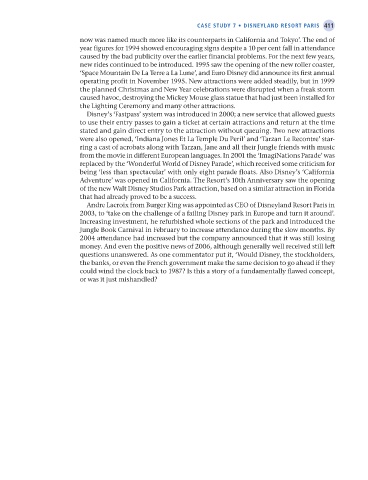Page 436 - Operations Strategy
P. 436
case study 7 • disneyland ResoRt PaRis 411
now was named much more like its counterparts in California and Tokyo’. The end of
year figures for 1994 showed encouraging signs despite a 10 per cent fall in attendance
caused by the bad publicity over the earlier financial problems. For the next few years,
new rides continued to be introduced. 1995 saw the opening of the new roller coaster,
‘Space Mountain De La Terre a La Lune’, and Euro Disney did announce its first annual
operating profit in November 1995. New attractions were added steadily, but in 1999
the planned Christmas and New Year celebrations were disrupted when a freak storm
caused havoc, destroying the Mickey Mouse glass statue that had just been installed for
the Lighting Ceremony and many other attractions.
Disney’s ‘Fastpass’ system was introduced in 2000; a new service that allowed guests
to use their entry passes to gain a ticket at certain attractions and return at the time
stated and gain direct entry to the attraction without queuing. Two new attractions
were also opened, ‘Indiana Jones Et La Temple Du Peril’ and ‘Tarzan Le Recontre’ star-
ring a cast of acrobats along with Tarzan, Jane and all their Jungle friends with music
from the movie in different European languages. In 2001 the ‘ImagiNations Parade’ was
replaced by the ‘Wonderful World of Disney Parade’, which received some criticism for
being ‘less than spectacular’ with only eight parade floats. Also Disney’s ‘California
Adventure’ was opened in California. The Resort’s 10th Anniversary saw the opening
of the new Walt Disney Studios Park attraction, based on a similar attraction in Florida
that had already proved to be a success.
Andre Lacroix from Burger King was appointed as CEO of Disneyland Resort Paris in
2003, to ‘take on the challenge of a failing Disney park in Europe and turn it around’.
Increasing investment, he refurbished whole sections of the park and introduced the
Jungle Book Carnival in February to increase attendance during the slow months. By
2004 attendance had increased but the company announced that it was still losing
money. And even the positive news of 2006, although generally well received still left
questions unanswered. As one commentator put it, ‘Would Disney, the stockholders,
the banks, or even the French government make the same decision to go ahead if they
could wind the clock back to 1987? Is this a story of a fundamentally flawed concept,
or was it just mishandled?
Z07 Operations Strategy 62492.indd 411 02/03/2017 13:45

